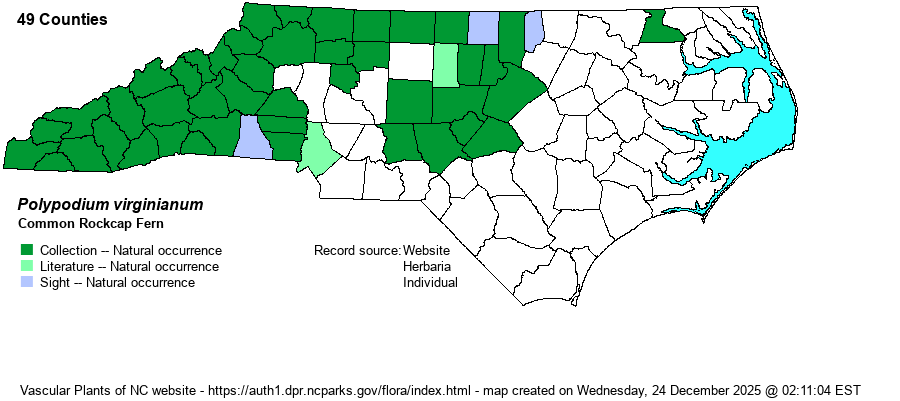| Author | L. | |
| Distribution | Throughout the Mountains; present over nearly all of the Piedmont, but may be locally absent in parts of the northeastern counties and south-central ones as well. Apparently one record from the northern Coastal Plain (Hertford County). With the splitting out of P. appalachianum from the original P. virginianum (broad sense), the ranges of the two are somewhat muddled, and there is no guarantee that P. virginianum (strict sense) has truly been collected in all of the counties as shown on the map below. Specimens of the 2 species at herbaria need careful ID.
The strict sense species ranges from eastern Canada south to central NC, central GA, and AR. | |
| Abundance | Apparently common -- at least the broad sense taxon -- in the Mountains; infrequent to locally fairly common in most of the Piedmont, but rare in the south-central and northeastern portions. Very rare along the VA border in the Coastal Plain. | |
| Habitat | This is a rock-inhabiting species, growing on many types of rocks, but usually in shaded situations. It grows best in cool forests on various boulders, in mesic to moist situations; it is not found on dry, exposed rocky summits or dry cliffs. |
| Phenology | Fruits from June to October. | |
| Identification | This species and P. appalachianum are extremely similar, with the latter recently pulled out from the broad sense P. virginianum. Each is evergreen, with a stipe about 4 inches long and a blade about 6-8 inches long and 2-3 inches wide. The blades are dark green above, glabrous, and pinnately cut. There are 12-20 pairs of pinnae, alternate, finger-like and rounded at the tips, with entire margins. The undersides of the blades are not pocked with numerous dark scales as are the blades of Pleopeltis michauxiana. The sori are rounded and in two rows, one on each side of a pinna midrib on the blade underside. P. virginianum has the "Leaf blade averaging 4.5 cm [nearly 2 inches] wide (range of 3.0-5.8 cm); blade widest near the middle, thus blade oblong to narrowly lanceolate in outline … leaves mostly with an attenuate, unlobed tip". P. appalachianum has "Leaf blade averaging 5.8 cm [about 2.5 inches] wide (range of 3.2-8.2 cm), widest at the base, thus the blade elongate-deltoid in outline … leaves mostly lobed to apex, without an attenuate, unlobed tip". | |
| Taxonomic Comments | None, other than the former P. virginianum from RAB (1968) days has recently been split into two species now, both of which occur in the state.
| |
| Other Common Name(s) | Rock Polypody, Common Polypody, Virginia Polypody. Rock Polypody seems to be the most often used common name, but that name borrows a scientific name (Polypodium) as part of the name; it is best to avoid parts or derivatives of Latin names in the common names. | |
| State Rank | S5 | |
| Global Rank | G5 | |
| State Status | | |
| US Status | | |
| USACE-agcp | | |
| USACE-emp | | |

